
This article presents step-by-step instructions and expert tips on how to write standard operating procedures (SOPs). We provide free, easy-to-use Word and PowerPoint SOP templates, along with a checklist to prepare for and write SOPs.
Included on this page, you will find steps on how to write a standard operating procedure, detailed SOP templates, information on SOP formats, and and many more tips and best practices.
A standard operating procedure, or SOP, is a step-by-step set of instructions to guide team members to perform tasks in a consistent manner. SOPs are particularly important for complex tasks that must conform to regulatory standards. SOPs are also critical to ensuring efficient effort with little variation and high quality in output.

Giles Johnston is a Chartered Engineer who consults with businesses to improve their operational processes and is the author of Effective SOPs. He defines SOPs as “the best agreed way of documenting the carrying out of a task.”

To Charles Cox, a Principal at Firefly Consulting, a boutique consulting firm that specializes in innovation and operational excellence, and a featured contributor to the book Innovating Lean Six Sigma, “SOPs are fundamental to a company’s success.”
SOPs describe how employees can complete processes in the exact same way every time so that organizational functions and outputs remain consistent, accurate, and safe. “SOPs don’t exist in a vacuum. They come from somewhere, and it’s essential that their place in the system be identified. To a large extent, SOPs are the foundation of a company’s operations: If you have no SOPs or inadequate SOPs, your company’s processes are impaired; impaired processes lead to the inadequate execution of policies and so on,” says Cox.
In any organization, all departments — from production to business operations to marketing to sales to legal to customer service — should have SOPs. Defined procedures apply in almost all fields, including agriculture, manufacturing, insurance, finance, and more.
SOPs may be required by regulatory agencies like the Occupational Safety and Health Administration (OSHA), the Environmental Protection Agency (EPA), the Department of Transport (DOT), and the Food and Drug Administration (FDA), as well as government legislation like the Sarbanes-Oxley Act (SOX). Standard operating procedures often fulfill voluntary best practices of standards like OSHA Voluntary Protection Programs (VPP), Information Technology Infrastructure Library (ITIL), Six Sigma, International Financial Reporting Standards (IFRS), GAAP (Generally Accepted Accounting Practices), and ISO 9001.
Standard operating procedures, including procedures, workflows, and work instructions, enable good communication and promote consistency in processes and output. SOPs help team members work toward common goals. Managers, team members, and consultants can come together to build processes and document those processes. SOPs, in conjunction with regular training and feedback, guide teams to success.
SOPs are important in clinical research and practice, such as in pharmaceutical processing. In these and other areas, SOPs bolster processes that require triage, segregation of origins, or tracking of cause and effects. In clinical settings, well-prepared SOPs can save an organization from FDA warnings and Form 483 sanctions. The international quality standard ISO 9001 requires companies to document manufacturing processes that can affect the quality of output.
Cox explains, “Training requires consistency. We should not be training new employees based on our own idiosyncrasies.” According to Cox, machine-focused enterprises have less variation than human-focused tasks, such as in the insurance or banking industry, where processes center on manual effort, customer service, and human interaction. SOPs can help companies create consistency within procedures.
Furthermore, SOPs provide reminders for people. “When people do things infrequently, they do not recall or do them well,” Cox explains. “For tasks you perform on a daily basis, you may not need a detailed SOP. But the things that are tricky and that you do infrequently may require work instructions. For things that you do infrequently, you may have to retrain every six months or so. When deciding what to add to an SOP, think about how often you do something, how difficult is it, how critical is it, and whether skipping this step leaves you open to problems,” says Cox.
Johnston thinks many people don’t understand the value of SOPs: “I think a lot of people see an SOP as simply a box that you check off to say that you’ve documented a process. They don’t understand that SOPs can be used to audit the process, to look at standards as training tools that ensure recruits are working in the correct way, or even just to guarantee uniformity in the way they conduct business.”
Johnston continues, “People don’t compute that you write these things and actually use them in your business. People think an SOP is something you write and store on a shelf. Then they act surprised when they make mistakes.”
As an example, Johnston describes a client that he helped with instituting an in-person customer feedback process. “My client’s name is above the door of his company,” explains Johnston. “One time, I accompanied my client on a visit to his client. And it was really awkward. The woman giving feedback was embarrassed. She had red ears, a red throat. But she did a great job of giving feedback,” he says.
Afterward, as Johnston and his client consoled themselves, Johnston fetched the company SOPs and showed his client that every learning point from the meeting had already been documented in their quality management system. “I said, ‘When are you guys going to use this document? And live and breathe it?’ My client thought and said, ‘It’s really straightforward, isn’t it?’ I said, ‘Yeah, because you wrote this thing five years ago.’”
Your task may be to update existing SOPs or to write new documents from scratch. In either case, creating SOPs involves more than just sitting down to write instructions. To write a useful SOP, it helps to have at least a basic understanding of the topic. However, you will also want to get input from others on the processes and on your written drafts. Here’s a step-by-step method to develop standard operating procedures.
SOP format refers to the way you structure your standard operating procedure documents. When selecting an SOP format, consider why you are creating the documents: Are they for regulatory compliance or strictly for internal use? There’s no right or wrong SOP format. Use what suits your documentation needs.
For greater ease as you research and write, create or find a template to work with. Your organization may already have SOP templates, or you can find templates online that match your purpose and industry. (To download free, customizable SOP template examples, see the link above to “Free Standard Operating Procedures Templates.”)
The length and format of an SOP depend on how much detail the document requires to clearly explain instructions and purpose. For example, packing instructions for workers in a book warehouse probably differ from those used by an FDA-compliant snack producer. It is crucial to clearly distinguish and label sections to help readers find what they need when they need it. After all, they may most want instructions when they are most agitated by a problem. There are four structural approaches to creating an SOP format:
Although documents can be either elaborate or simple, depending on your organization’s needs, most SOPs use at least some of the structural elements listed below:
With templates, it’s easier to write SOPs because you can concentrate on content without worrying about formatting. The following free, downloadable templates are also customizable for your organization’s needs.
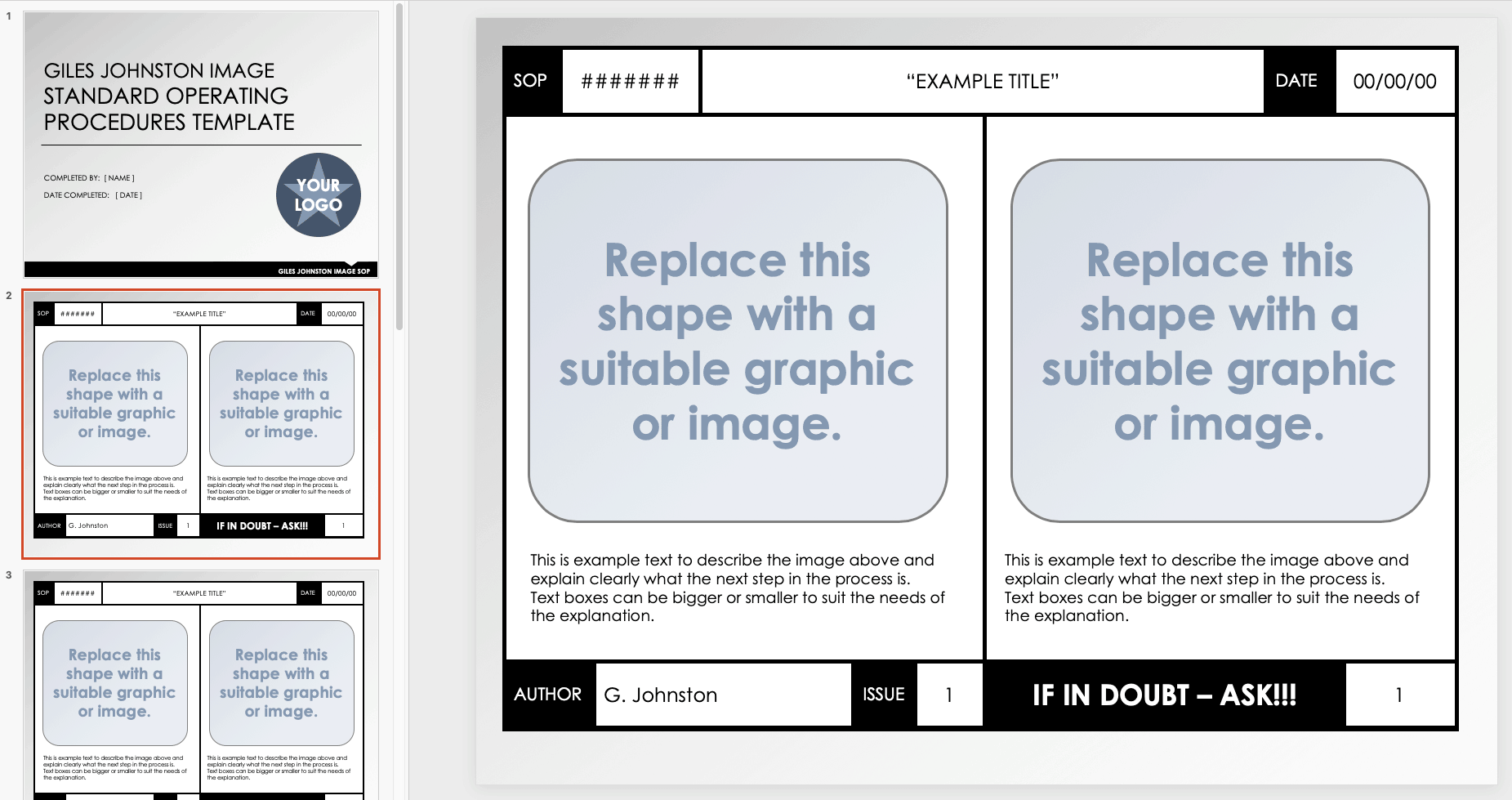
This PowerPoint work instruction template from Giles Johnston emphasizes the use of pictures and short bullet points for instructions. The template includes spaces for two images and a short paragraph or a few bullets for each slide in the deck. You’ll also find additional spaces for author name, date, slide number, and slide title.
Download Pictorial Standard Operating Procedure Template
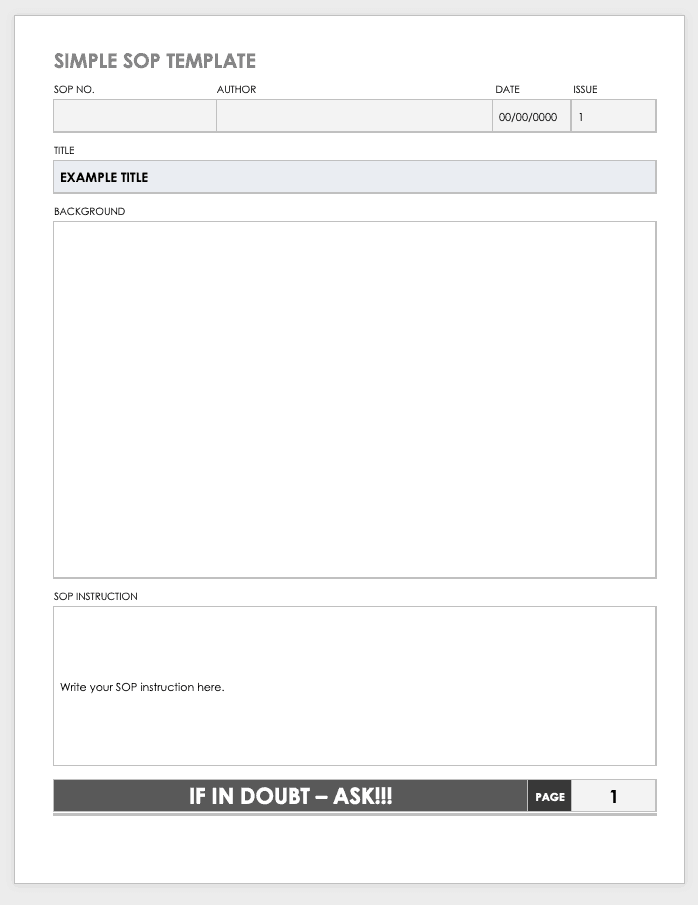
Johnston also offers this basic work instruction template. In addition to the meta information, such as author, SOP title, date, SOP number, and issue, this template provides a small space to describe the context of the procedure and a large space to fill with steps. As Johnston says of both templates, “They look pretty basic — until they’re populated!”
Download Simple Standard Operating Procedure Template
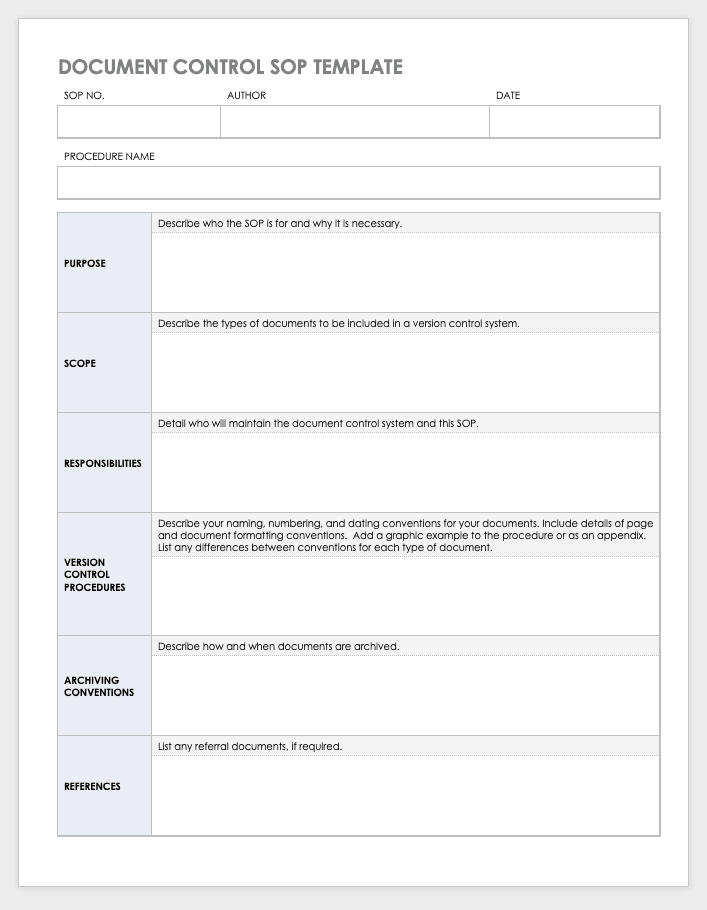
When collecting work-related documents, you likely have to standardize a system for formatting, naming, storing, and archiving. This document control SOP template helps you decide what documents to control, as well as how to format, name, number, store, and archive them. This template includes space for discussing who is responsible for document control and for updating the document control SOP.
Download Document Control Standard Operating Procedure Template
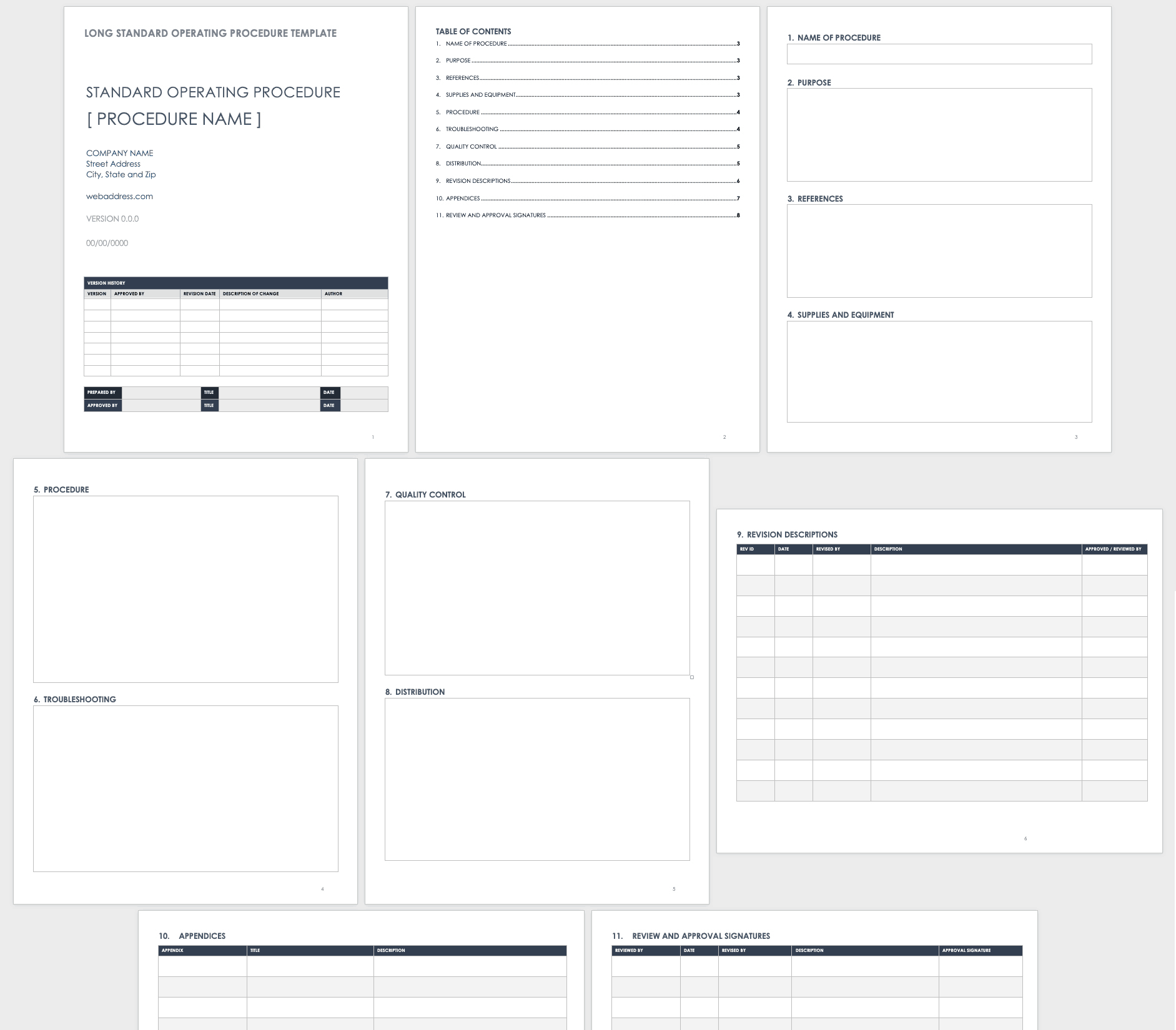
This template for a long SOP includes what many people think of as the SOP itself. In addition to identifying the SOP and describing its purpose, this template provides space to list reference documents, necessary supplies and equipment, troubleshooting information, quality control details, and an SOP distribution list.
Download Long Standard Operating Procedure Template
Charles Cox sums up the SOP writing process this way: “Take the de facto SOPs, come up with a standard, and write everything the exact same way every time. That way, people can get trained and refer to the documents with consistent expectations. Reduce text and increase pictures and graphic; add videos, if necessary. Whatever it takes to move from the world of de facto SOPs or de facto work instructions, do it.”
Giles Johnston sees the need for visual support from another perspective: “A lot of people don’t enjoy writing these.” College graduates may feel more comfortable with writing duties, but most of the workforce does not have the same educational background.
“Not everyone has the ability to translate activities into the written word. If people could get away from worrying about the style of writing and incorporate a few more images, rather than adding endless sentences, we’d probably get a lot more SOPs, written a lot more quickly,” Johnston emphasizes.
Your focus should be on conveying as much information as possible in a small space; the PowerPoint slides and bullet points from the pictorial standard operating procedure template above are a good example of this kind of economical communication. “Short can be effective,” says Johnston.
And make sure that you include all necessary details. “That’s one of the things I see time and time again; people don’t include all the steps,” laments Johnston. “They rush it out, and no one can follow it.” He advises writers to prepare for the “nitty gritty” of step-by-step instructions.
Johnston continues, “I joke with my clients that you have step one, then some magic happens, and you have step two. In reality, there may be 15 steps across a process that you need to capture. People glibly move past them, so it’s crucial to understand all the steps in a process.
“Before step one, maybe there’s a whole loading operation, and before that, maybe there’s a calibration and a maintenance check. You need to capture all that,” Johnston says.
What else should you know to write SOPs with confidence? Here are some important elements to keep in mind:
Sometimes, employees avoid SOPs because the documents contain difficult jargon and uninspiring layouts. Thick manuals full of obscure terminology were once staples of engineering and manufacturing environments. Although formal layouts may be necessary for certain standards, such as the FDA, that doesn’t mean procedures and work instructions can’t feature simple language and user-friendly design.
After you understand the larger process and workflow, it’s time to document the individual procedures. Whether you are an enthusiastic or reluctant procedure writer, do not underestimate the amount of time you need to document procedures. Follow these steps for clear and effective writing:
A standard operating procedure manual, known in ISO 9001 as the quality manual in a quality management system, provides a method for collecting your organization’s many procedures in one place. A manual can be as simple as a collection of Microsoft Word documents that you organize into a master document or a traditional binder with pages. “The operations manual provides a handbook for how the business operates day to day,” explains Johnston.
For Charles Cox, “In a very real sense, the information contained in the operating company’s documents impacts the ability of the personnel to meet and exceed expectations. If the documents are not well executed, the information will be difficult to access or understand. Then people will start making up their own approaches, which leads to needless increases in variability and a decline in quality.” Some fields, such as ITIL, have special names for their SOP manual. In ITIL, they refer to the SOP manual as a run book.
Cox says that an SOP manual can stand on its own, but is usually included in a quality manual, together with policies, processes, procedures, and work Instructions. “How a company splits up these four elements is at the discretion of management,” he explains. “Sometimes, only a few policies that directly impact operations are included in the quality manual, and the remaining policies or all policies go into a policy manual that only upper-middle and senior leadership can access,” he adds.
Alternatively, the quality manual may include only SOPs, inspection procedures, and work instructions. “There are many ways of arranging the documents; the arrangement must fit the requirements of the people who need access to the information. You need a clear understanding of the operating environment before designing the documents system,” Cox emphasizes.
Johnston describes what one of his clients created for their franchises:
An operations or SOP manual can work well as a repository for procedures, but you must be sure to link everything therein. Johnston cautions against orphans (i.e., pages and procedures that lack linkage to the rest of the document system). Users can stumble across content by accident. “Good linkage is like having a compass. Anywhere you’re dropped, you can find your way back,” he says.
Johnston warns, however, “If it’s hard to find a procedure and you’re busy, you don’t look for it; you just carry on as normal and run the risk of working in an incorrect manner.”
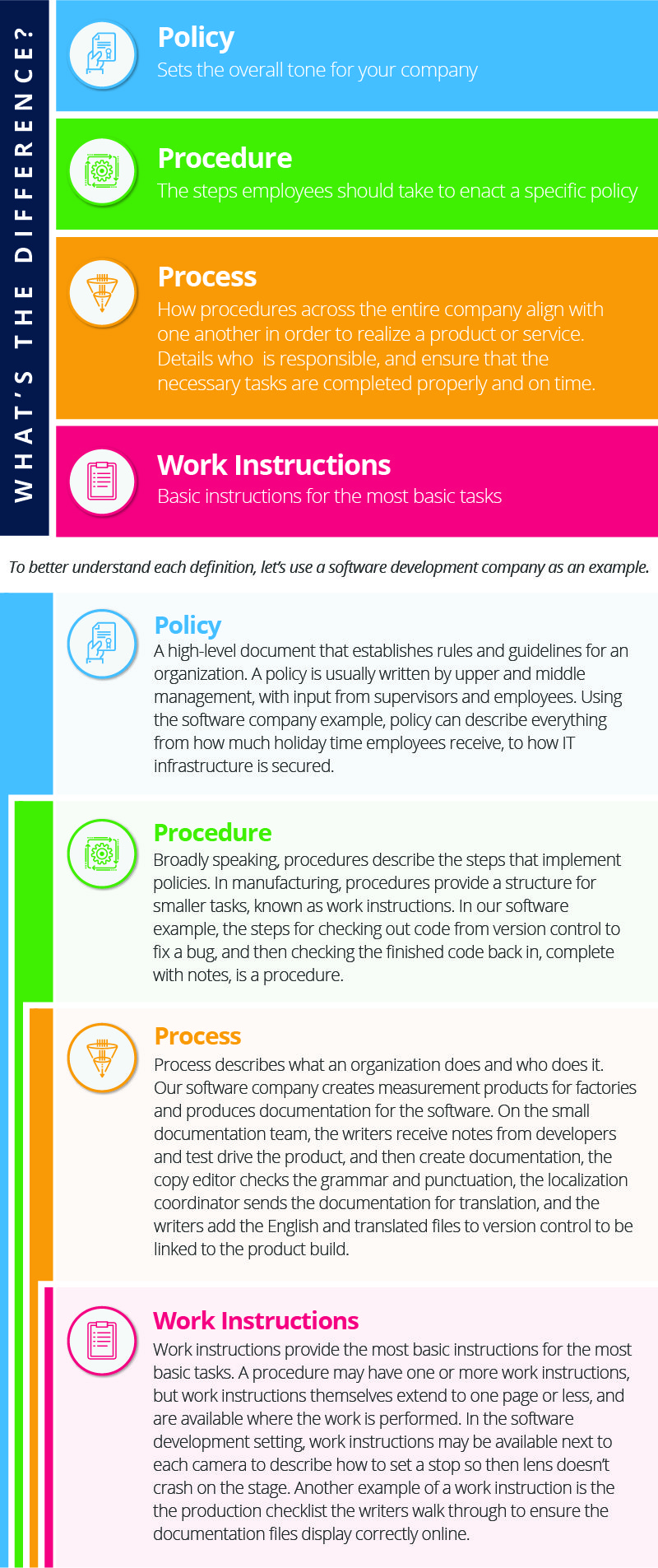
Procedures form a part of a management system by defining established or prescribed methods and processes. We build procedures from steps, which are the aspect of processes where individuals can introduce variation. SOPs provide the overall framework, while work instructions can change more often. "Procedures provide a description of who does what and when. An SOP characterizes relationships and control measures," says Johnston. Documentation is never a substitute for training.
The following is a hierarchy of SOP documents:
According to Cox, the human resource department stores various skills matrices, but for optimum efficiency, managers on the shop floor should keep this information. That way, when technical questions arise, the manager will know who is the in-house expert. In addition, if a team member calls in sick or goes on holiday, the manager will be able to identify capable individuals to perform specific tasks.
“One of the things I find fascinating is that we bring people into a company, sort of train them, and then hope for the best,” laments Giles Johnston. “If we’ve written SOPs, then it makes sense to have skills matrices that refer directly to those SOPs. That way, when someone starts, they can learn the correct way to do things and be judged against that standard; they can know who to ask questions, and we can have effective members of staff that we can track,” he recommends.
SOPs describe your unique business processes and the steps you require to finish those processes in accordance with industry, legal, in-house, and competitive standards. Procedures are step-by-step descriptions, whether predominantly text or graphics.
Standard operating procedures should form the basis of regular training and provide a structure of metrics for performance reviews. SOPs also help you achieve the following:
Despite potentially providing rich sources of information, SOPs are often consigned to shelves or hidden in the labyrinth of a file share system. Giles Johnston encourages people to build references to SOPs into business activities: “Learn to tie SOPs to your meetings, not necessarily to training. Usually, some element of an SOP pertains to your meeting and should be reflected particularly in your process meetings to guide people’s thinking. Instead of the SOP being separate from and adjacent to what you’re doing, it’s actually synonymous with what you’re doing.”
Johnston describes a company that included an SOP show-and-tell in its meetings. Senior managers were each given a separate SOP and four minutes to present a precis on how the SOP applied to the meeting. “It was fascinating what people brought back to the table, what they either hadn’t realized or had forgotten,” says Johnston.
He also gives an example of a company in which it previously took a new hire three months to become fully effective at their job. After the company updated its SOPs with enough imagery and clearer articulation and added a skills matrix, new employees became effective in about four hours.
A procedure lists the necessary steps to complete a task, particularly those in a process or cycle. You usually assign sequential numbers to the steps in a procedure (which may also contain substeps). In general, instructional procedures should contain no more than seven steps. Below, we use the example of a procedure for washing dishes in an industrial dishwasher:
SOPs detail procedures that you use in your organization to perform activities according to industry and statutory standards, as well as your internal specifications. Procedures include any documents that describe how to perform an action, whether in words or pictures, in print or online.
SOPs are an important part of a quality management system. Standard operating procedures describe the recurring tasks in a quality operation. Written SOPs reduce errors by detailing the required manner for performing a task. When you update processes and training plans, you should also update the SOPs. When you follow this method, SOPs become a means for notifying employees of process changes. SOPs may be essential for processes that are critical to quality (CTQ).
You need not only to format your SOPs, but also to store them, so everyone can easily access them. Software can help. Business process management software, for example, allows you to store procedures online and track usage from one view. The following are some of the different products you can use to create, review, update, and publish your documents:
Standardization and SOPs are the outcomes of industrialization, specifically the effort to prevent major accidents. The 1856 train disaster in Pennsylvania occurred when railway engineers in two trains approaching an intersection acted on conflicting interpretations of the rules of the road. The public remonstrations led to the standardization of procedures and what we now know as SOPs. The dramatic example set by the accident showed that unconsidered processes and informal communication cause problems. The example also illustrated how step-by-step procedures clarify processes.
Empower your people to go above and beyond with a flexible platform designed to match the needs of your team — and adapt as those needs change.
The Smartsheet platform makes it easy to plan, capture, manage, and report on work from anywhere, helping your team be more effective and get more done. Report on key metrics and get real-time visibility into work as it happens with roll-up reports, dashboards, and automated workflows built to keep your team connected and informed.
When teams have clarity into the work getting done, there’s no telling how much more they can accomplish in the same amount of time. Try Smartsheet for free, today.